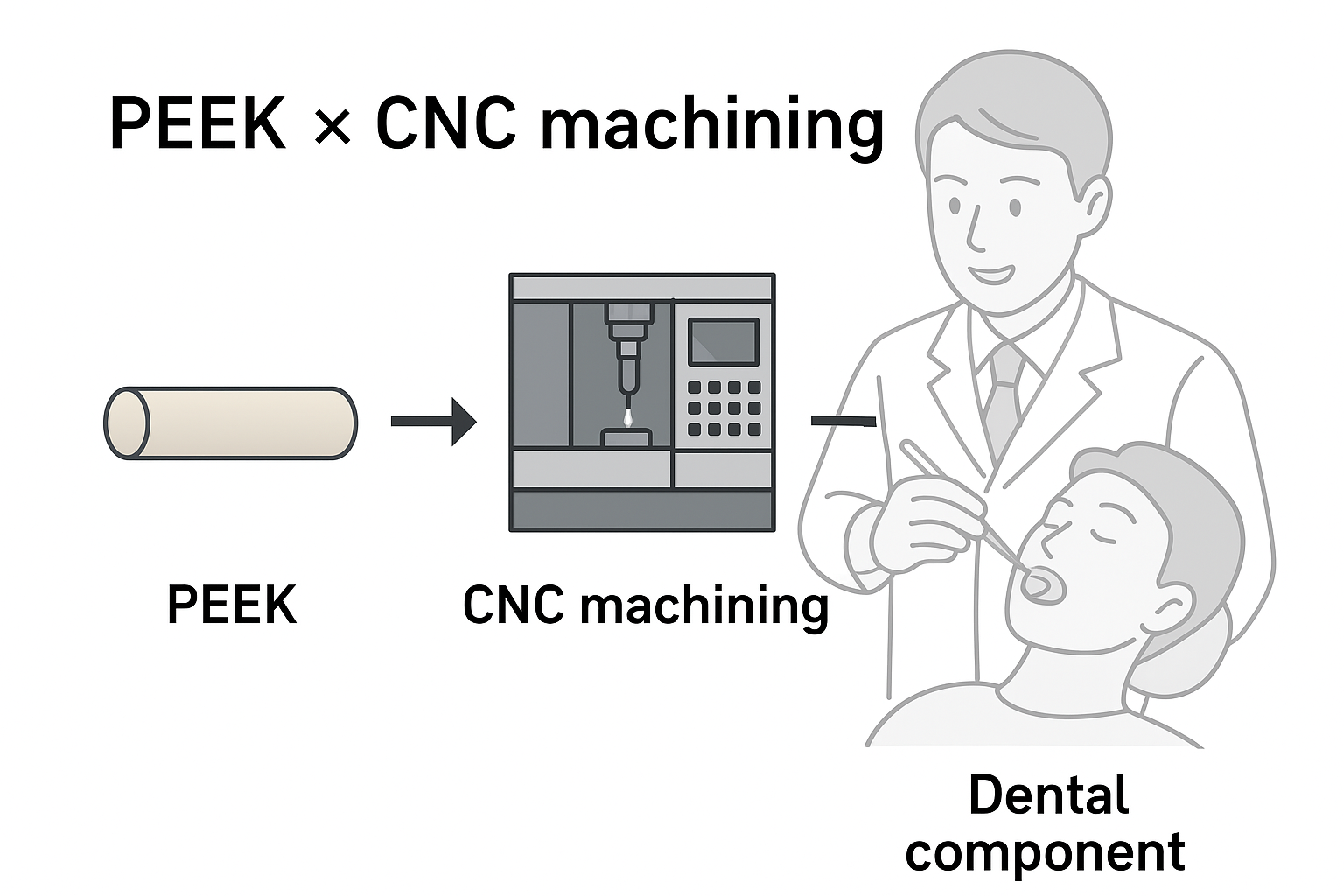PEEK (Polyether Ether Ketone) and CNC machining industry complete supply chain structure, from raw materials → forming → precision machining → assembly applications → downstream industries, explained step by step:

—
PEEK and CNC Machining Industry — Complete Supply Chain Diagram (Text Version)
① Upstream: Raw Material Supply
● Raw material manufacturers
Produce PEEK resin (such as Victrex, Solvay, Evonik)
Provide PEEK pellets, PEEK rods, PEEK plates, and PEEK tubes
● Material processing plants
Extrude PEEK resin into rods, plates, and films
Provide semi-finished products that can be directly machined by CNC
—
② Midstream: PEEK Forming Processes
Mainly divided into two forms for CNC manufacturers:
A. Forming Processes (providing blanks for CNC)
1. Injection molding
Suitable for mass-produced parts (medical devices, electronic housings).
2. Extrusion
Produces PEEK rods/plates/tubes — the most common raw form for CNC machining.
3. 3D printing (FDM / SLS high-temperature printing)
Used for complex lightweight structures, often combined with CNC secondary machining.
—
③ Midstream: CNC Precision Machining (Core Value)
When PEEK semi-finished products enter CNC machining, they become high-precision components.
Main CNC processes:
CNC Turning (Lathe): pipes, shafts, ring-shaped parts
CNC Milling: precision components, cavities, mechanical assemblies
5-axis machining: complex medical and aerospace parts
Secondary processes: fine grinding, polishing, deburring
Advantages of CNC machining PEEK
Accuracy up to ±0.01 mm
Heat resistance to 250°C
High wear resistance, high strength, chemical resistance
Can replace metals (titanium, aluminum) to reduce weight
—
④ Downstream: Application Industries
1. Medical Industry
Interbody cages
Medical catheter components
Dental treatment parts
Robotic surgical arm components
2. Aerospace & Defense
Lightweight structures
Insulation holders, mounts
Heat-resistant / pressure-resistant parts
3. Semiconductor Equipment
Chemically resistant components
Common in Taiwan: fixtures, positioning blocks, sliders, thermal insulation pads
4. Precision Industry & Automation
High-wear sliding components
Robotic joint sleeves
Connectors, pressure-resistant fittings
PEEK × CNC Machining Industry Chain (Summary)
Raw material manufacturers → PEEK material suppliers (plates/rods)
→ Forming processes (injection/extrusion/3D printing)
→ CNC high-precision machining (turning/milling/5-axis)
→ Surface treatment / QC
→ Assembly / equipment manufacturers
→ Medical / semiconductor / aerospace / industrial automation

How PEEK Works in Medical Applications and How It Integrates with CNC Machining
✅ The Role of PEEK in Medical and Healthcare Applications
PEEK (Polyether Ether Ketone) is a high-performance engineering polymer with:
- High strength and low weight
- High temperature resistance (steam-sterilizable)
- Excellent biocompatibility (implant-grade)
- Chemical and fatigue resistance
- Radiolucency under X-ray and CT (no metal artifacts)
Common medical applications include:
- Spinal fusion cages
- Dental implant abutments
- Surgical tools and disposable guides
- Joint replacement components
- Orthopedic fixation plates
🌟 Manufacturing Workflow of PEEK Medical Devices
Medical components require high precision, surface quality, and durability.
PEEK machining differs from metals and demands advanced control.
🏭 CNC + PEEK Integration Process
1️⃣ Raw Material Preparation
- PEEK rods or sheets
- Medical-grade or implant-grade PEEK (e.g., Invibio)
2️⃣ CNC Machine Setup (Core Process)
Machining PEEK focuses on high speed, low cutting force, and thermal control.
Key considerations:
- Tools: Sharp carbide end mills and drills
- Spindle speed: 10,000–24,000 rpm
- Feed rate: High feed to prevent melting
- Cooling: Air cooling or MQL (avoid emulsions due to moisture absorption)
- Workholding: Soft jaws to prevent deformation
3️⃣ CNC Machining of Medical Components
Example – PEEK spinal cage manufacturing:
- Rough milling
- Contour shaping
- Slotting and hole machining
- Surface texturing for osseointegration
- Fine finishing
4️⃣ Inspection & Quality Control
- CMM dimensional measurement
- Surface roughness testing (Ra 1.6–0.8 μm)
- Radiolucency verification
- Strength & fatigue tests
5️⃣ Cleaning & Sterilization
PEEK supports:
- Autoclave
- Gamma radiation
- EtO sterilization
6️⃣ Assembly, Packaging & Certification
Depends on application:
- ISO 13485
- USP Class VI
- FDA 510(k) / CE approval
🔧 Why CNC Machining Is Ideal for PEEK in Medical Devices
- High precision (±0.01 mm)
- No metal-like internal stress during machining
- Ability to create complex 3D structures
- Suitable for small-batch customized medical components
📌 Summary
PEEK’s biocompatibility and mechanical strength make it a leading implant material, while CNC machining provides the precision and flexibility required for advanced medical manufacturing.
#PEEK #CNCmachining #CNCprecisionmachining #SemiconductorComponents #AutomationEquipment #PrecisionParts #RobotArm #StainlessSteelMachining #EngineeringPlastics #CeramicMachining
Yong Yi Technology Co., Ltd.
📍 188-9, Section 1, Dafeng Road, Tanzih District, Taichung City 42756, Taiwan
📞 +886-4-25341382
📞 +886-4-25341847
✉️ yongyi-sales@umail.hinet.net
✉️ justinwu6767@gmail.com

